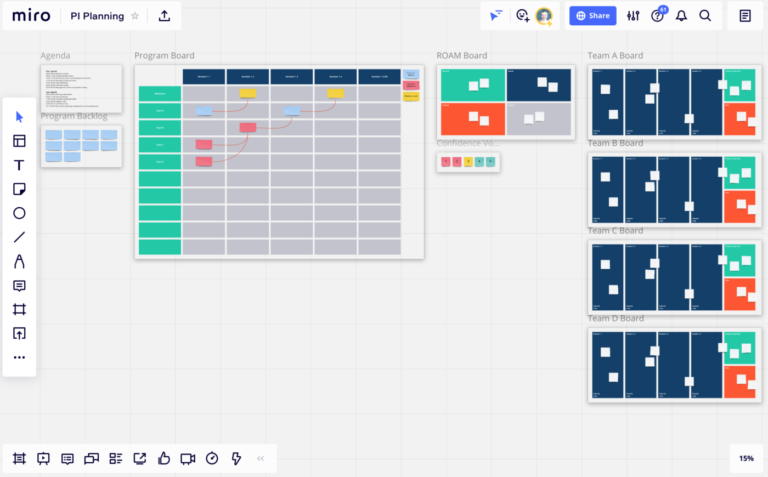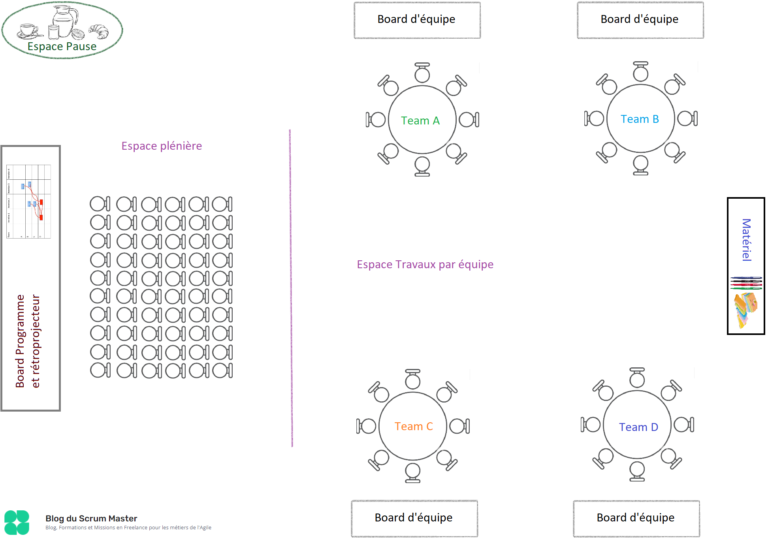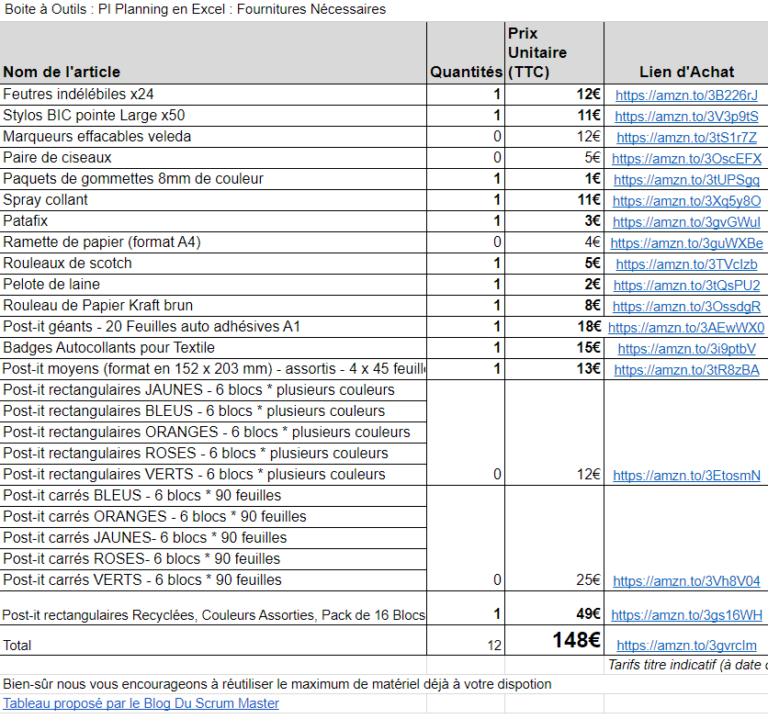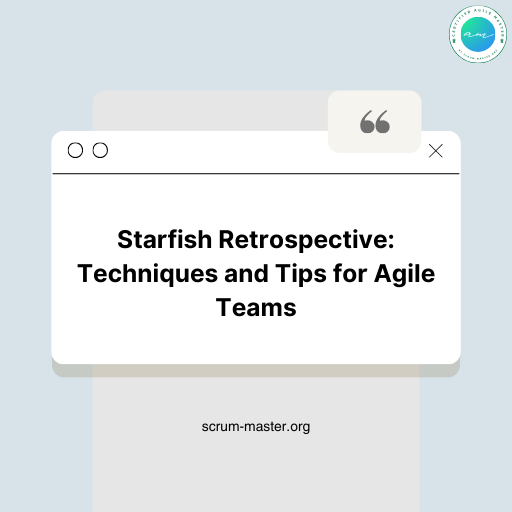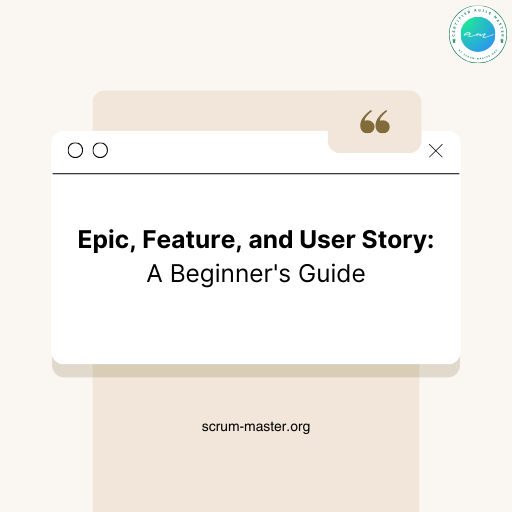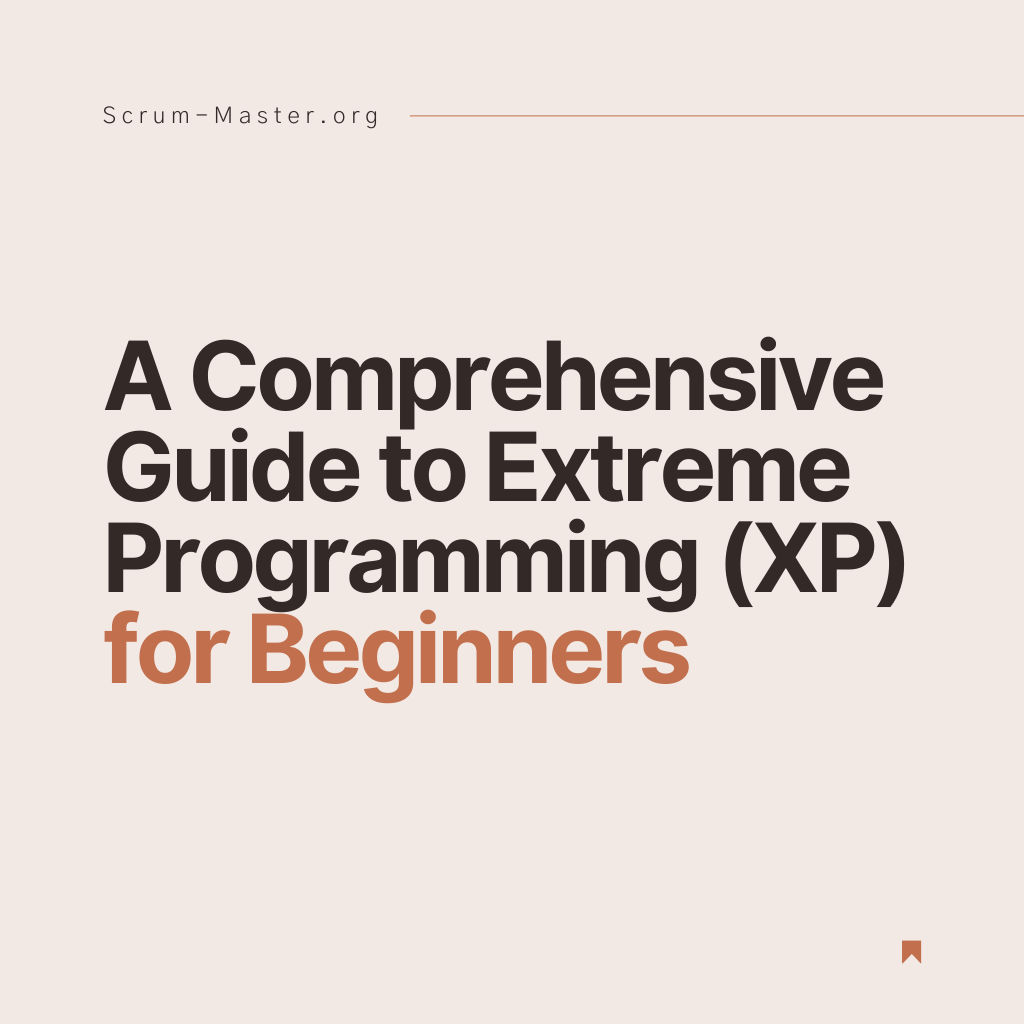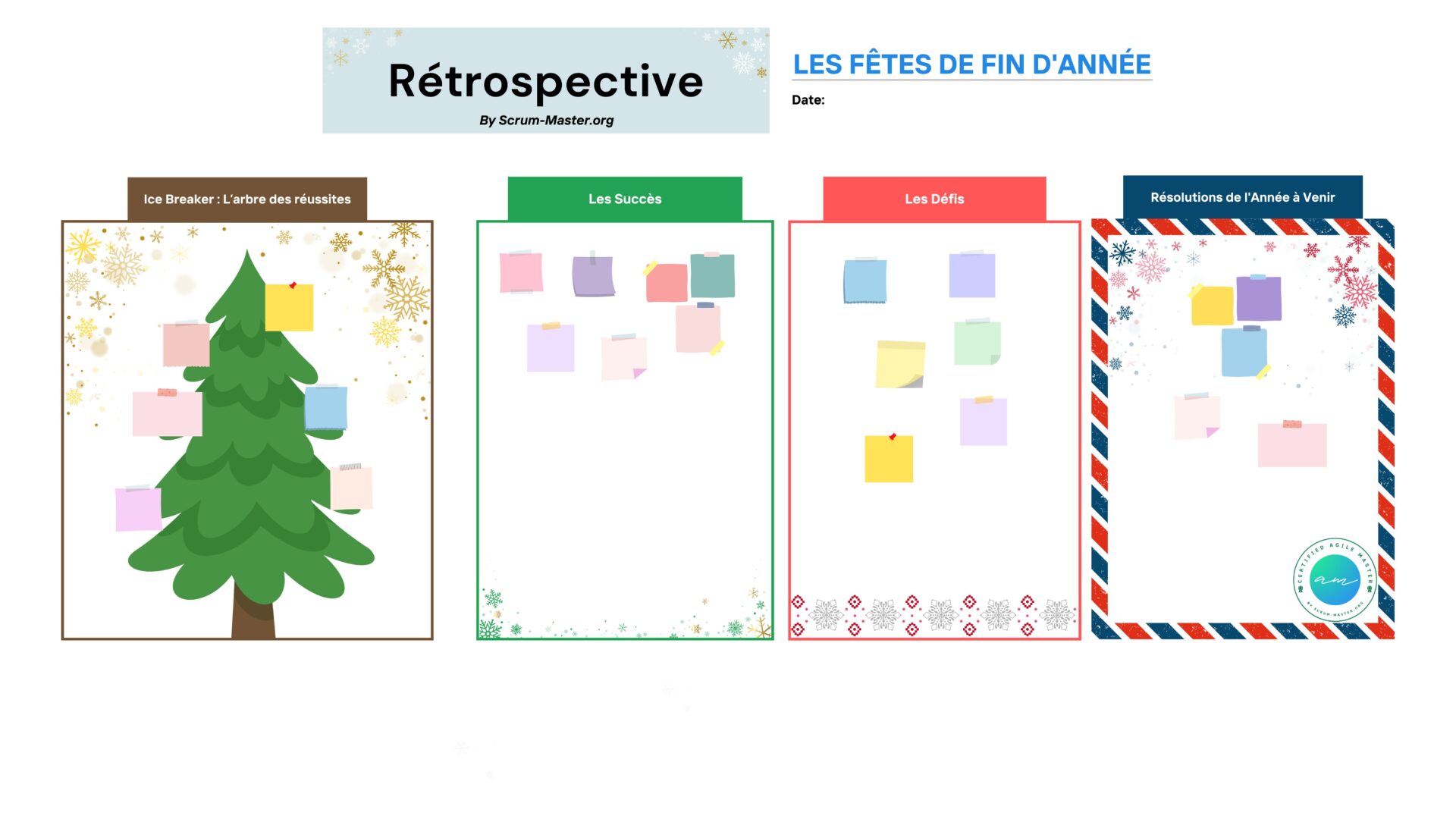PI Planning, or Planning Interval, is a pivotal event within the Scaled Agile Framework (SAFe). It serves to synchronize teams and stakeholders around a unified mission and vision. This ceremony, adaptable for face-to-face or hybrid modalities, is vital for the effective execution of SAFe. Whether you’re a Release Train Engineer (RTE) or a Scrum Master (transitioning to Team Coach in SAFe 6.0), orchestrating a PI Planning session is both a significant challenge and a key determinant of project success.
This guide aims to furnish you with proven strategies and practical tips for meticulously preparing your PI Planning, whether conducted in-person or remotely. Additionally, you will discover an Excel toolbox at the conclusion of this guide, designed to support you through each critical phase of preparation.
Index
- 1 What is a SAFe PI Planning?
- 2 Who should be invited to PI Planning?
- 3 Which Agenda for Your PI Planning?
- 4 Which online tools should you choose for your remote PI Planning?
- 5 Organizing In-Person PI Planning: A Comprehensive Guide
- 6 Unlock Your PI Planning Success Kit (Excel File)
- 7 FAQ : PI Planning SAFe
What is a SAFe PI Planning?
PI Planning is a core event, typically held quarterly, that congregates members of the Agile Release Train (ART) in SAFe. Its goal is to outline the activities and objectives for the subsequent planning interval—an 8 to 12-week development cycle. This collaborative effort aims to yield tangible, impactful results.
Objectives of PI Planning:
- Strategic Alignment: Ensures that all ART teams share a comprehensive understanding of and commitment to the organization’s vision and strategic goals. PI Planning fosters robust communication and inter-team collaboration, which are essential for collective efficiency.
- Feature Planning: Drafts a detailed roadmap for feature development and delivery throughout the next PI, aligning with customer requirements and business objectives.
- Inter-team Dependency Management: Actively identifies and resolves dependencies among teams to mitigate bottlenecks and delays in delivery.
- Risk Management: Proactively anticipates, evaluates, and strategizes the management of potential risks, enhancing the organization’s preparedness for unforeseen challenges.
These objectives underscore the integral role of PI Planning in ensuring the smooth and coordinated execution of projects within a SAFe environment, while promoting a culture of agility and collaboration.

PI Planning Inputs
For a successful PI Planning session in SAFe 6.0, certain preconditions, or inputs, are necessary to steer the discussion and planning phases:
- Business Context: A comprehensive overview of the business scenario and market influences shaping the ART’s strategy and priorities. Essential for grounding the planning in real-world demands and objectives.
- Architectural Vision: Insight into the proposed system architecture, highlighting technological advancements and necessary adjustments. This sets the stage for innovative development paths and integration strategies.
- Epics/Features Prepared: A catalogue of epics and features that have undergone refinement (Backlog Refinement) and meet the Definition of Ready (DoR), poised for discussion and inclusion in PI Planning.
Incorporating these inputs ensures that the planning is informed, focused, and aligned with both current capabilities and future aspirations.
PI Planning Outputs
The fruits of effective PI Planning are indicators of ART’s synchronization and preparedness:
- PI Goals: Articulated SMART (specific, measurable, achievable, relevant, time-bound) objectives set by each team, with business values ascribed by Business Owners. This aligns team efforts with overarching business aims.
- PI ART Board: Visual representation of team commitments to feature delivery across sprints, showing inter-team dependencies and significant milestones. A critical tool for visual management and progress tracking.
- PI Risks: Catalogue of identified potential risks to the program increment, facilitating foresight and proactive management of challenges.
These outcomes lay the foundation for a structured and productive PI Planning, ensuring effective coordination and goal alignment across all ART teams.
Who should be invited to PI Planning?
Crucial Roles for PI Planning Success
The effectiveness of PI Planning within the SAFe framework hinges on the active participation and commitment of key roles within the Agile Release Train (ART). The Release Train Engineer (RTE), responsible for orchestrating this pivotal event, extends invitations to a diverse group of essential participants. Each plays a significant role in shaping and executing the Program Increment, contributing their unique insights and expertise to the planning process. Below, we explore the essential participants required at various levels of SAFe implementation and their critical contributions:
For Essential SAFe Implementation:
- Product Owner: Charged with feature and user story prioritization, their insight ensures developments are perfectly aligned with end-user needs. Gain further understanding in our dedicated Product Owner article.
- Scrum Master: The linchpin for Scrum teams, aiding in navigating challenges and streamlining processes. Delve into the Scrum Master’s role in our comprehensive article.
- Developer: Essential for the technical execution of features, contributing to the planning of capacity and resources.
- Product Manager: Offers a broad product vision, aligning development with the organization’s strategic goals. Explore more in our Product Manager insight.
For “Large Solution” SAFe Implementation:
- Solution Manager: Oversees the development of complex solutions, ensuring coordinated efforts across teams.
- Solution Architect/Engineer: Ensures architectural coherence and technical integration throughout the Solution Train.
At the Portfolio Level of SAFe Implementation:
- Epic Owners: Direct major initiatives or ‘Epics’, aligning them with strategic business goals.
- Enterprise Architects: Offer a comprehensive architectural overview, ensuring technological initiatives are strategically aligned.
The early identification and confirmation of these participants are vital, impacting the logistical planning, equipment needs, and overall event size. To facilitate participant management, an example table is available in the Excel toolbox at the article’s conclusion.
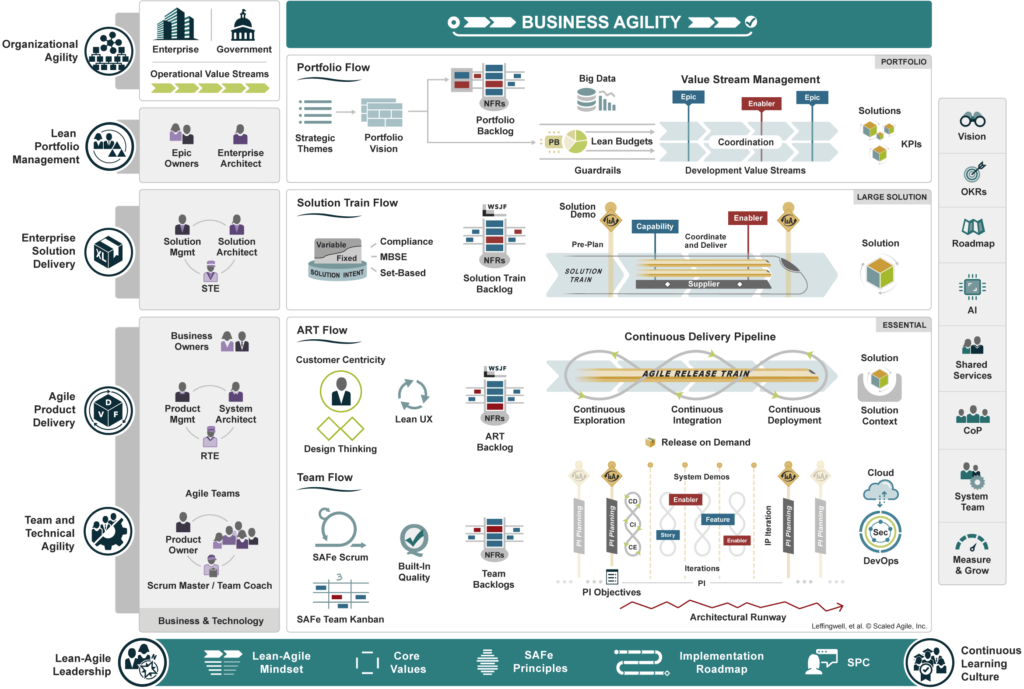
Which Agenda for Your PI Planning?
PI Planning stands as a pivotal two-day gathering within the SAFe framework, designed to align team efforts and objectives for the upcoming Program Increment. While SAFe provides a standard agenda, customizing it to fit the unique demands of your Agile Release Train (ART) can significantly enhance the planning’s effectiveness.
SAFe’s Standard PI Planning Framework
At its core, PI Planning is meticulously structured, comprising various sessions aimed at fostering strategic alignment, feature planning, inter-team coordination, and proactive risk management. This comprehensive approach ensures that all participants are not only on the same page but are also actively contributing to a cohesive plan for the forthcoming PI.
Day One: Establishing the Foundation
The first day of PI Planning is critical, setting the tone for the event with sessions including:
Business Context”: This session is where Business Owners or Managers shed light on the current market standing and strategic challenges confronting the ART. It’s a foundational briefing that steers the direction of PI Planning.
“Product/Solution Vision”: Here, Product Managers unveil the prospective vision of the product or solution, spotlighting imminent features and milestones. This session ensures all teams are aligned with the product roadmap.
“Architecture Vision”: Presented by the System Architect or Engineer, this segment introduces the proposed system architecture, emphasizing development practices like DevOps and automated testing, pivotal for the forthcoming IP.
“Planning Context” by RTE: The RTE delineates the agenda and anticipated outcomes of PI Planning, setting the stage for the forthcoming collaborative sessions.
“Team Breakouts”: Integral teamwork sessions where groups ascertain their iteration capacities and pinpoint backlog elements crucial for upcoming Sprints.
“Plan Review”: An opportunity for teams to exhibit the fruits of Team Breakouts, discussing capacities, IP objectives, and emergent risks.
“Management Review and Problem-Solving”: Dedicated to addressing challenges highlighted during the “Plan Review,” this involves collaborative discussions on plan amendments and resolution strategies.
Breakout sessions are where the magic happens, with teams estimating their capacities and pinpointing essential backlog items for upcoming Sprints. This collaborative effort culminates in a Draft Plan Review session, where teams present their findings, discuss potential risks, and outline their PI objectives.
Concluding the first day, the Management Review session acts as a strategic alignment forum. Here, leadership and teams converge to dissect and address critical concerns—dependencies, priorities, deadlines, and risks. This ensures that the forthcoming day’s team breakout sessions are primed for success, with a clear focus on overcoming challenges and achieving alignment.
Day Two: Refinement and Retrospective
Planning Adjustments”: Initiates with a synopsis of adjustments necessitated by the prior day’s discussions.
“ART PI Risks”: Teams brainstorm and deliberate on potential risks for the forthcoming PI. Utilizing strategies like the ROAM Matrix can significantly mitigate these risks.
“Confidence Vote”: Conducted by the RTE, this essential vote gauges the teams’ confidence in fulfilling the IP objectives.
“Plan Rework”: Necessary adjustments are made to ensure a robust level of confidence in the plan.
“Planning Retrospective & Moving Forward”: A reflective session to harvest feedback and refine the orchestration of future PI Planning events.
The following day focuses on refining plans based on the previous day’s discussions, identifying and addressing PI risks, and solidifying team confidence in meeting the PI objectives. It’s a time for adjustment, reflection, and forward-thinking, with a Planning Retrospective session dedicated to enhancing future PI Planning events.
Tailoring PI Planning to Your ART’s Needs
Adapting the PI Planning agenda to the specificities of your ART is crucial. In my role as RTE, we found enriching to include three Team Breakout sessions, diverging from the standard two. This adaptation, among others, underscores the importance of flexibility in meeting your team’s unique needs and expectations.
Ensuring that the PI Planning agenda is comprehensively communicated to all participants is paramount. Providing accessible resources, such as a customizable PI Planning agenda template in Excel format, facilitates smoother preparation and engagement. This template, available for download, serves as a versatile foundation that you can tailor to align with your ART’s unique needs and objectives.
By thoughtfully adapting the standard SAFe agenda to your ART’s context, you enhance the efficacy of your PI Planning, fostering a more aligned, informed, and prepared Agile Release Train ready to tackle the challenges of the next Program Increment.
More than 3500 Participants in this Udemy e-learning!
Which online tools should you choose for your remote PI Planning?
In the era of widespread telework and geographically dispersed teams, selecting the right online tools is pivotal for executing successful SAFe PI planning. Whether you aim to foster collaboration among remote teams or accommodate a flexible work environment, the tool’s choice is critical to the success of these PI planning events.
This segment emphasizes two primary tools that simplify remote PI planning, offering insights into their advantages and potential drawbacks.
Miro: Your Go-To for Collaborative PI Planning
Miro has emerged as a valuable asset for online Scrum retrospectives and is equally indispensable for PI planning sessions. Its intuitive design and comprehensive features make it an exemplary platform for collaborative planning processes. Access a comprehensive Miro template for your PI Planning Board, enhancing your planning effectiveness.
Advantages of Miro for Online PI Planning:
- Accessibility: Start without upfront costs with Miro's free version, perfect for SAFe ARTs beginning their journey.
- User-Friendliness: Miro's intuitive interface and extensive template library, including PI Planning templates, facilitate ease of use.
- Enhanced Task Management: Integrate Miro with Jira to streamline task and backlog management, available with the premium version.
Challenges with Miro:
- Free Version Limitations: Limited access to templates and no direct Jira integration without the premium version.
- Board Organization: A Miro board may become quickly overwhelmed if not managed properly, necessitating effective space management.
iObeya: Visual Management for Complex PI Planning
iObeya excels in visual management, meeting the demands of large-scale groups and complex PI planning processes. It enables the creation of multiple boards to simplify every phase of your SAFe PI Planning, ensuring a seamless online experience.
Why choose iObeya for PI Planning?
- Simplicity: With a user-friendly interface and templates, iObeya simplifies the PI planning process.
- Effortless Integration: Seamlessly synchronize with Jira for program backlog and task updates.
Challenges with iObeya
- No free version: iObeya requires an investment, which might be a consideration for smaller teams.
- Performance Limitations: High user traffic might lead to performance dips, affecting large PI planning sessions.
- License Management: Effective access control is crucial to avoid overcrowding and manage subscription costs efficiently.
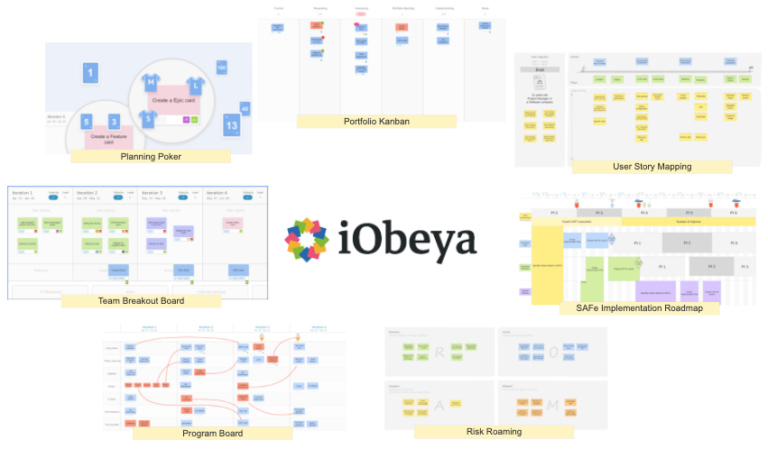
In conclusion, while both Miro and iObeya offer powerful features for facilitating remote PI Planning, my preference leans towards Miro for its ease of use, especially for beginners. The accessibility of a wide range of PI Planning templates in the Miroverse, available for free, significantly streamlines the planning process. This abundance of resources not only enhances the efficiency of planning sessions but also provides invaluable support for SAFe practitioners navigating the complexities of PI Planning for the first time.
Organizing In-Person PI Planning: A Comprehensive Guide
Selecting the Ideal Venue for PI Planning
Selecting the Ideal Venue for PI Planning
The foundation of a successful in-person PI Planning event is the selection of an appropriate venue. It is essential to choose a space that comfortably accommodates all participants, fostering an environment conducive to collaboration and effective communication. Here are strategies for optimal spatial organization:
Strategic Team Placement: Position teams with significant interdependencies in close proximity to enhance communication and streamline the collaboration process during breakout sessions.
Designated Areas for Varied Activities: Create distinct zones for plenary sessions and team-based work. Utilize the plenary area, equipped with the ART PI Board and an overhead projector, for overarching presentations and discussions.
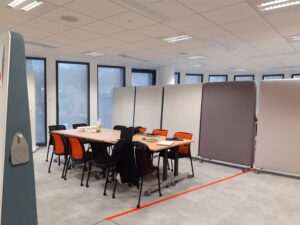
Managing Noise in Large Gatherings: For PI Planning events with numerous attendees, managing noise levels is critical to maintain a conducive working environment. Employ acoustic partitions or, for gatherings exceeding 50 participants, consider allocating different rooms for team breakouts. This approach minimizes distractions, ensuring focused and productive team discussions.
Accommodating Remote and Multi-Site Teams: When incorporating telecommuting participants or teams from various locations, assigning separate rooms equipped with remote connection capabilities is advisable. This setup guarantees seamless integration of remote members into the planning process, ensuring equitable participation from all members, regardless of their physical location.
Clear Signage: Implement well-defined signage to guide participants through the venue effortlessly, from navigating between sessions to locating the event space. An accessible and well-marked venue enhances the overall experience and efficiency of the planning event.
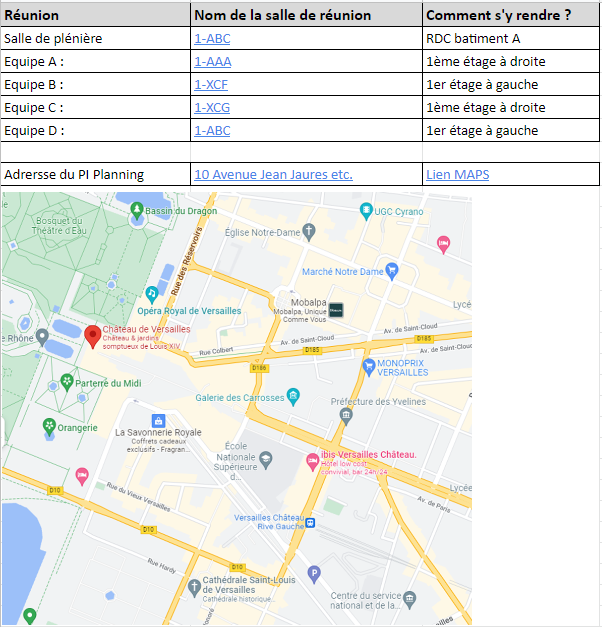
Essential supplies for Effective PI Planning
Based on my extensive experience orchestrating more than twenty PI Planning sessions, I have compiled an essential equipment list tailored for diverse event sizes and needs. This meticulously developed checklist guarantees that your face-to-face PI Planning session is fully prepared for success, smoothly accommodating up to five teams and sixty participants over the course of three sprints.
Download the essential equipment checklist for PI Planning to fully prepare for your event. This resource is meticulously tailored to support sessions involving significant collaboration, ensuring every aspect of your PI Planning is seamlessly facilitated.
Unlock Your PI Planning Success Kit (Excel File)
Elevate your PI Planning with our essential Excel toolkit. Designed for both new and seasoned planners, this toolkit includes:
- Customizable PI Planning agendas for Day 1 and Day 2.
- Participant tracking for seamless coordination.
- A comprehensive supply list for in-person sessions.
- Venue layout templates for easy navigation.
- Quick links to online tools for effective virtual planning (With Miro).
Complete the form below to download your toolkit and start preparing for your PI Planning with confidence :
FAQ : PI Planning SAFe
PI planning is a SAFe framework ceremony that requires a certain amount of preparation. The ceremony lasts 2 days and brings together around 50 people for workshops and meetings. This makes it possible to plan the work to be delivered over the next few Sprints.
What’s more, this meeting is “standardized” by SAFe and has a standard agenda that you can reuse or adapt to your own context.
For the preparation of this meeting we must distinguish 2 possible cases:
- Or you can carry out this PI planning in physics. and this means reserving a large meeting room. As well as stationery and other necessary materials.
- Or PI Planning takes place remotely. So you’ll need to choose the right online tools to facilitate this event.
A typical PI Planning session takes place over two days and follows a structured agenda to maximize collaboration and alignment between teams. Here are the key steps:
Opening and Background: Day one begins with presentations to establish the business context, product vision and architectural vision. These presentations provide teams with the information they need to plan effectively.
Team Planning Sessions: Teams then meet to discuss and plan their work for the next Program Increment. They identify the functionalities to be developed, the inter-team dependencies and set SMART objectives.
Plan review and adjustment: Teams present their plans and receive feedback. If there are problems or concerns, plans are adjusted accordingly.
Vote of Confidence and Closing: At the end of the second day, a vote of confidence is held to ensure that everyone is comfortable with the commitments made. Finally, PI Planning ends with a retrospective and the setting of next steps.
This process ensures that all ART teams are aligned on the same objectives and clearly understand their responsibilities for the next increment.
Details of each stage of the PI Planning process can be found in the PI Planning agenda section of this article.
SAFe, or Scaled Agile Framework, is a comprehensive methodological framework for applying agility on a large scale. It integrates multiple elements to facilitate the coordinated work of several agile teams, while preserving their individual agility. Here are the key SAFe components:
Roles: SAFe defines specific roles for the efficient operation of teams at program, portfolio and corporate level.
Ceremonies: The framework includes structured ceremonies, such as PI Planning, which coordinate the efforts of agile teams.
Artifacts: SAFe uses various artifacts to ensure alignment and tracking, such as program and portfolio backlogs.
Lean-Agile principles: combines Lean and Agile principles to optimize value delivery and product quality.
Architecture and Technical Design: SAFe emphasizes architecture and design practices that support flexibility and scalability.
Lean Portfolio Management: Management of development initiatives aligned with business objectives.
Culture and Leadership: Foster a culture of enlightened leadership focused on autonomy, innovation and continuous improvement.
For more information, the official SAFe for Lean Enterprises definition is an essential resource. In addition, the “SAFe from Zero to Hero” training course on Udemy is an excellent option for an in-depth understanding of SAFe, with over 1,400 participants giving positive reviews.
In SAFe 6.0, the term “PI”, which previously stood for “Program Increment”, has been redefined to mean “Planning Interval”. Here are the key details:
Planning Interval :
- The Planning Interval is a fixed period, usually 8 to 12 weeks, during which an Agile Release Train (ART) focuses on delivering incremental value.
- This concept emphasizes continuous planning and execution, providing a time frame for team alignment, collaboration, and the delivery of concrete results.
- Planning Interval helps synchronize team efforts, encouraging an iterative, incremental approach to achieving defined objectives.
PI Planning :
- The Planning PI is an event that marks the start of each Planning Interval. This is an intensive planning session where ART members come together to align their efforts and plan the work for the upcoming Planning Interval.
- It plays a crucial role in ensuring that all ART teams understand the vision, objectives, priorities and dependencies for the next planning interval.
In short, the Planning Interval in SAFe 6.0 is the development cycle, while PI Planning is the planning event that initiates and structures this cycle.
The organization of PI Planning is typically the responsibility of the Release Train Engineer (RTE) within the Scaled Agile Framework (SAFe). RTE acts as facilitator and coordinator for the event, ensuring that all necessary aspects are taken into account. Here are the key responsibilities of the RTE in the organization of PI Planning:
Event planning: RTE plans the event in terms of logistics, agenda and participants. This includes reserving space, organizing the necessary resources and coordinating schedules.
Content preparation: Prior to PI Planning, the RTE works with Product Managers, Product Owners and System Architects to prepare presentations on the business context, product vision and architectural vision.
Event Facilitation: During PI Planning, the RTE facilitates sessions, helps resolve issues and ensures that the agenda is followed. Their role is crucial in keeping the event on track and ensuring that objectives are met.
Post-event follow-up: After PI Planning, RTE helps to finalize plans, resolve remaining issues and ensure that teams are ready to start Planning Interval.
RTE therefore plays a central role in the success of PI Planning, ensuring effective coordination and fluid communication between all the parties involved.

